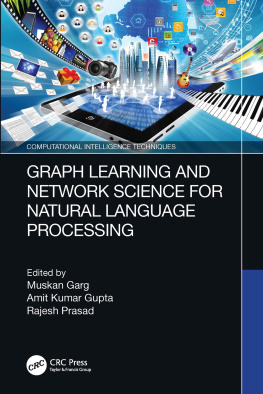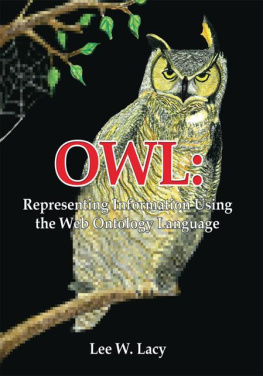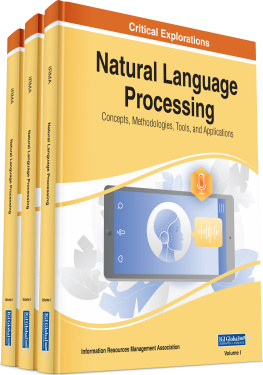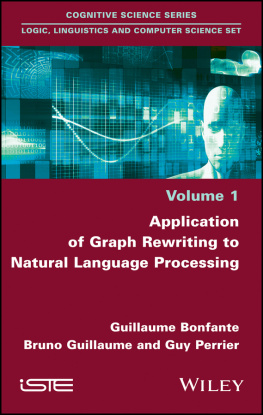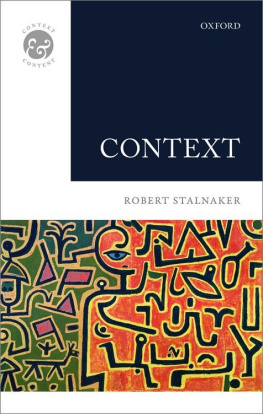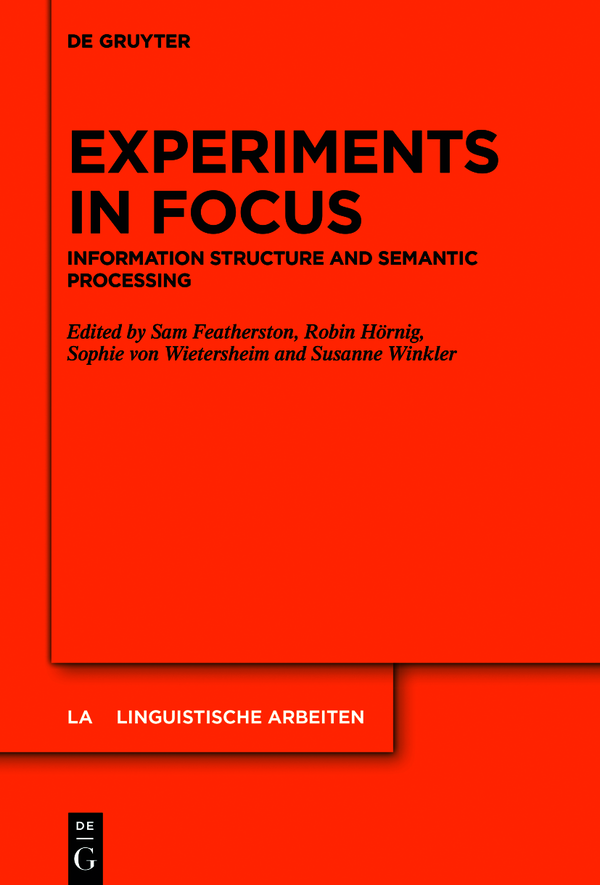Experiments in Focus
Linguistische Arbeiten
Edited by
Klaus von Heusinger
Agnes Jger
Gereon Mller
Ingo Plag
Elisabeth Stark
Richard Wiese
Volume
Experiments in Focus
Information Structure and Semantic Processing
Edited by
Sam Featherston
Robin Hrnig
Sophie von Wietersheim
Susanne Winkler
ISBN 9783110618402
e-ISBN (PDF) 9783110623093
e-ISBN (EPUB) 9783110622287
Bibliographic information published by the Deutsche Nationalbibliothek
The Deutsche Nationalbibliothek lists this publication in the Deutsche Nationalbibliografie; detailed bibliographic data are available on the Internet at http://dnb.dnb.de.
2019 Walter de Gruyter GmbH, Berlin/Boston
Markedness in context: An approach to licensing
Robin Hrnig ,
Sam Featherston ,
Sophie von Wietersheim and
Susanne Winkler
This volume is a collection of selected papers that adopt an experimental approach to questions of information structure and processing. The concept of information structure we employ here includes, but is not limited to, theories of focus, issues of markedness, and contextual licensing. Since these features are used by the parser to guide incremental interpretation, it is of great interest to consider not only how these factors are represented in the language, but also how they contribute to processing. The major research questions that these papers address are as follows:
What are the various devices with which the grammar encodes information-structural concepts such as unmarked (wide) focus or marked (narrow or contrastive) focus?
How do lexical phenomena such as discourse particles and syntactic constructions interact with information structure?
How do such discourse status factors as givenness, parallel vs. non-parallel focus, and common ground management interact?
How can the differences between marked and unmarked word orders be described? And how does context influence the licensing of these structures?
What approaches can linguists adopt to help them disentangle the different factors that play a role in processing sentences in context?
The papers in this volume address these questions and propose answers. These papers are unified in their interest in the representation and implementation of aspects of interpretation and processing, and the conviction that experimental methods can yield insights. Within this unity, they vary in their methodological approach, theoretical concerns, and linguistic aims. In the following, we show how empirical studies can address such mental processes as the extraction of meaning from linguistic forms in context, but we shall begin by sketching the papers in their relationship to the common heading of the markedness of a linguistic form and, related to it, the idea of contextual licensing. inquiry into the nature of normal accentuation (normale Betonung) and normal constituent order (normale Wortstellung). The reader may tentatively equate normal with unmarked; Hhle speaks of relatively unmarked (relativ unmarkiert).
Pairs of linguistic forms that are similar, but not identical, usually have differences of meaning that are specific to the differences in form, so differences in form without a corresponding difference in meaning call for a justification. Sometimes the solution seems to be that the forms then differ in information-structural function. One such function is focus. The goal is to establish a systematic form-function mapping for those cases where differences in form correlate with a difference in function. One way of signaling a difference in focus is prosody. In English and German, for instance, speakers can do this by a differential placement of the most prominent pitch accent, illustrated in (1a) versus (1b) (the syllable in bold and small capitals carries the pitch accent).
(1)
a.
The woman burnt the book .
b.
The wo man burnt the book.
(2)
a.
What did the woman burn?
Superficially, (1a) and (1b) do not differ in meaning, in the sense that they arguably share the same truth conditions; however, they can function as the answers to different questions. This difference does not depend upon an issue of the facts in the world, but rather depends upon what the questioner already knows about the facts. Question (2a) is more likely to be answered with (1a), whereas question (2b) is more likely to be answered with (1b). Native speakers probably do not consider (1a) a felicitous answer to (2b). They will perhaps consider (1b) an even less felicitous answer to (2a).
When we consider the assertions (1a) and (1b) as possible answers to questions, we see that the questions differ in the requested information, whereas the answers differ with respect to the constituent carrying the pitch accent. The felicity of a question-answer pair depends upon their matching in terms of focus. The content of the question word determines the focus in the question; the pitch accent signals which part of the answer the speaker considers to be the focus. This correspondence of focus in questions and answers is called question-answer congruence.
This congruence relation provides a nice way to illustrate how very similar sentence forms may differ in their information-structural qualities, for instance, in their focus quality. An equally important research issue is how to determine the focus of an utterance, which is part of an ongoing discourse rather than the answer to an explicit question. A first guess would be that the utterances (1a) and (1b) would be part of different discourses. More generally, the encoding of focus in a linguistic form signals a set of contextual requirements on the surrounding discourse. The constraints on the preceding context can, as in (1) and (2) above, be fulfilled by a question, but need not be. The intuitive appeal of questions in an alternative semantics approach to focus is pointed out by Zimmermann & Ona (2011:1652): Intuitively, focus marking on the subject in (1) [= PE\ter went to Paris] indicates that alternative propositions of the form x went to Paris are relevant for the interpretation of (1); for instance, (1) would constitute an ideal answer to the wh-question Who went to Paris? In any event, if the two linguistic forms (1a) and (1b) signal different contextual requirements by virtue of their difference in linguistic form, they are expected to be uttered in different contexts, and it is this sort of external evidence of focus within linguistic examples that permits an experimental approach to these questions.
This is then the empirical perspective on these issues taken in this volume. If we take (1a) and (1b) as being uttered in the contexts (2a) and (2b) respectively, then they would make up a coherent story; we can experimentally test whether the story is not only coherent but accurately reflects the behavior of speakers. We present, for instance, (1a) or (1b) together with the alternative contexts (2a) and (2b) to native speakers and ask them to choose the context that better fits the assertion. If our hypothesis is correct, they will behave in the way that we predict. If they dont, well have to revise our theory and test again.



